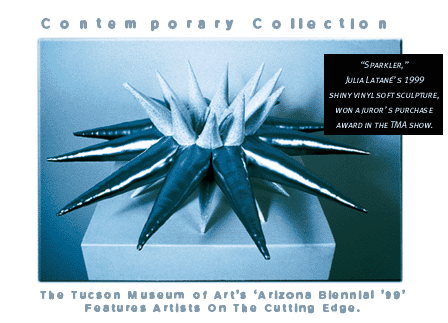
By Margaret Regan
IT'S PROBABLY SAFE to say that the George McCullough Cash Award
for the Best Work in Metal in the Arizona Biennial has
never before gone to art that's made out of straight pins. Or
underpants.
This year it did. Specifically, the metal prize went to 90,000
metal pins, each endowed with a fake pearl head, and thrust into
a big pair of underpants. Proudly arrayed on a sculptural pedestal,
the pearls transform the knickers' cloth surface into a sea of
glittering white globes; the innards become an uninhabitable forest
of dangerously sharp points. (You can see the pointy ends of the
pins by peeking into the underpants' leg and waist openings.)
Artist Angela Ellsworth of Phoenix dreamed up an apt title for
a piece meticulously composed of 90,001 separate parts: "My
Compulsion Is Your Consumption."
Her prickly oeuvre is one of some 120 works by 70 artists
in the big Tucson Museum of Art Arizona Biennial '99, an
every-other-year juried event that showcases art from throughout
the state. Ellsworth is not alone in using materials that wield
the shock of the new.
 John Franzone of Klondyke arranged metal car parts into
a vicious pooch ("Junk Yard Dog") and Maggie Leininger
of Phoenix has lined up 144 wax-cast dish-detergent bottles on
the floor ("Women Marching"), their pale pastel formation
evoking a depressing lifetime of dishwashing. A giant latex condom,
"Created Identities: Safe Sex Portrait" by Gregory Sale
of Phoenix, formerly of Tucson, hangs on a wall, and a real-cloth
Little Red Riding outfit is given a decent burial in a black coffin
in Tucsonan Kelly McGehee's "Fairy Tale 26: LRC (fragments)."
John Franzone of Klondyke arranged metal car parts into
a vicious pooch ("Junk Yard Dog") and Maggie Leininger
of Phoenix has lined up 144 wax-cast dish-detergent bottles on
the floor ("Women Marching"), their pale pastel formation
evoking a depressing lifetime of dishwashing. A giant latex condom,
"Created Identities: Safe Sex Portrait" by Gregory Sale
of Phoenix, formerly of Tucson, hangs on a wall, and a real-cloth
Little Red Riding outfit is given a decent burial in a black coffin
in Tucsonan Kelly McGehee's "Fairy Tale 26: LRC (fragments)."
Even the best of show juror's purchase awards went to the outré.
"Sparkler," a pointy, silver-cloth soft sculpture stitched
by Julia Latané, director of Tucson's infant Museum of
Contemporary Art, is vaguely reminiscent of Miss Liberty's crown.
Michael Campbell's "Buff" is a dangling bristly brush
in strident red and green.
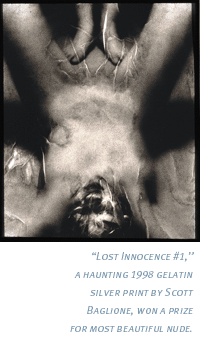 Nowhere at all is there anything remotely resembling a cowboy
on a horse, nor even a more up-to-date abstracted rendering of
the Sonoran landscape in thick oils. No reworkings of Mexican
folk craft either, and hardly any gorgeously printed black-and-white
photographs. In fact, with its real cake and oranges, animated
subway video, foam-rubber sea monsters and 365 vitamin bottles
in latex (Sale again), '99's look bears no resemblance
to the aesthetic of Biennials past.
Nowhere at all is there anything remotely resembling a cowboy
on a horse, nor even a more up-to-date abstracted rendering of
the Sonoran landscape in thick oils. No reworkings of Mexican
folk craft either, and hardly any gorgeously printed black-and-white
photographs. In fact, with its real cake and oranges, animated
subway video, foam-rubber sea monsters and 365 vitamin bottles
in latex (Sale again), '99's look bears no resemblance
to the aesthetic of Biennials past.
In recent years, the Biennials have been selected by three-person
juries, resulting in gentlemanly but slightly addled conglomerations
of every conceivable art trend in the state. Hand-crafted tables
stood among desert-inspired paintings, manipulated photos shared
space with fine gelatin silver prints. Usually a wrangler or two,
in paint or bronze, popped up among the avant-garde installations,
standing faithful sentinel to the enduring popularity of cowpoke
art. Not this year.
What's going on?
THE SHORT ANSWER is that the museum's last biennial of the 20th
century was juried by a single person, and that person happens
to be the director and curator of SITE Santa Fe, a cutting-edge
New Mexico arts space that's about four years old. The 40-something
Louis Grachos has spent his whole career working with what he
calls "advanced" contemporary art, interning at New
York's Whitney Museum, curating at San Diego's Museum of Contemporary
Art. And the works he chose for the TMA, the cloth sculptures,
the found objects, the noisy board game, are right in sync with
the avant-garde elsewhere in the U.S. and in Europe.
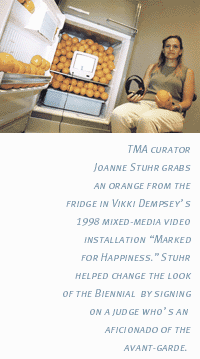 "It's work that is very informed," Grachos declares
by telephone from his Santa Fe home. "People living in Phoenix,
Tucson or small Arizona towns are engaged in ideas and shifts
that are international. These people are committed to art and
challenging the convention. Instead of a regional dialogue there
are artists like this."
"It's work that is very informed," Grachos declares
by telephone from his Santa Fe home. "People living in Phoenix,
Tucson or small Arizona towns are engaged in ideas and shifts
that are international. These people are committed to art and
challenging the convention. Instead of a regional dialogue there
are artists like this."
The long answer has to do with the whole sweep of 20th-century
art. Such works as Christine Sandifur's three-dimensional "Tea
Party," a table and chairs set for a trio of disembodied
dresses, may be puzzling to a general Tucson audience, but in
1999 such work already has deep art-historical roots.
"Duchamp in the '20s was doing 'ready-mades,' " Grachos
says. "There's no direct linkage but the idea of the ready-mades
still prevails. Think of the collages by Picasso and Braque (in
the teens). Painting could be more than oil on canvas, sculpture
could be more than carving marble. These ideas have been brewing.
"In the late '80s, there was a shift in creation, in the
use of made and found materials.... Today there's a commitment
to extending the material as far as it will go.... The doors have
been flung open."
TMA curator Joanne Stuhr, who invited Grachos to judge the
show, made a deliberate choice to abandon the group jurying for
a single judge with a definite point of view.
"I like this show," she says. "It has
a nice, clean vision. It's very easy to tell it's one juror. (Multiple)
jurying is often a compromise. If one person is particularly strong,
the others' (viewpoint) can get washed out."
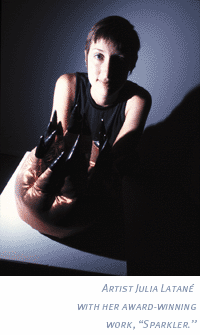 Stuhr agrees with Grachos that materials are now the frontier
of art.
Stuhr agrees with Grachos that materials are now the frontier
of art.
"The feeling of this whole century, the latter part anyway,
has been questioning, redefining what art is, pushing things to
the very limit," Stuhr says. "That's happened in a number
of ways: simplifying the picture plane. Abstraction. It just goes
further and further and further. One of the last territories to
test in that way was media.
"It's not so easy to define what art is anymore. It's not
confined to a picture plane or the top of a pedestal. Or to paint,
acrylic, marble, whatever. Certainly within the last 30 years
those definitions have been torn apart."
Arizona artists have been experimenting with new media for years,
of course. They've responded to their own time by working with
the deluge of mass-produced objects among which all of us frenzied
consumers live, and purloining the new computer and video technologies
that have altered human life forever. The TMA has occasionally
dipped its toe into this new genre pool, notably in its New
Directions series showcasing local artists, but this is its
first major show.
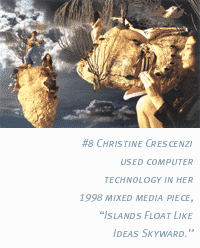 "We're a little bit behind the trend," Stuhr acknowledges.
"Nobody's working with chocolate or meat although we do have
cake. It is a real cake, and real oranges."
"We're a little bit behind the trend," Stuhr acknowledges.
"Nobody's working with chocolate or meat although we do have
cake. It is a real cake, and real oranges."
The food, more benign than the real-meat art that shocked London
audiences last year, is part of a video installation and mixed-media
piece in the Biennial called "Marked for Happiness"
by Tucsonan Vikki Dempsey. For some years Dempsey has run the
summertime VideoTensions series at the UA; this past winter she
debuted "Marked" at the opening of the Museum of Contemporary
Art at HazMat Gallery. One of its three videos--narrative works
about the artist, her mother, grandmother, and such issues as
food and weight and health--is embedded in a layer cake.
"It's a different cake, new cake and new oranges,"
Stuhr says. "At HazMat Gallery, somebody took a piece (of
cake). Vikki liked that."
EATS ASIDE, THERE'S still room for conventional materials in the
elastic aesthetic of Biennial '99, including paintings
recognizable as paintings. Peter Young, Bisbee resident and recent
exhibitor at Tucson's Elizabeth Cherry Contemporary Art, is showing
three acrylic and graphite works on canvas, all of them delicate,
flatly painted abstractions. "#56-1998" is a rhythmic
swirl of interlocking circles and ovals. Greens fill in some of
the shapes, others are left blank.
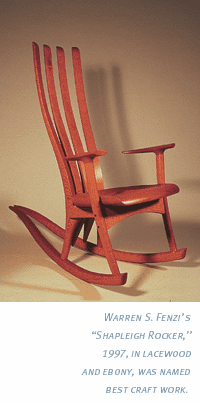 Olivier Mosset, a Swiss painter who's moved to Tucson, goes way
beyond Young in flatness. Not a single brushstroke is detectable
in his two large canvases, earlier versions of which were seen
at HazMat last winter in the MOCA opening show. Mosset also shoves
his canvases beyond the usual rectangle: "May Day" is
rounded at top and bottom, and "Untitled" is pointed.
Olivier Mosset, a Swiss painter who's moved to Tucson, goes way
beyond Young in flatness. Not a single brushstroke is detectable
in his two large canvases, earlier versions of which were seen
at HazMat last winter in the MOCA opening show. Mosset also shoves
his canvases beyond the usual rectangle: "May Day" is
rounded at top and bottom, and "Untitled" is pointed.
The spareness of Mosset's paint, so unlike the vigorous expressionism
of many Tucson painters, comes out of "a strong tradition
of monochrome or field painting over the last 30 years,"
Grachos says. "At the time Olivier started showing internationally
(there was a) dialogue of how far painting can be pushed. It's
still happening.
"The magic in his painting is his incredible use of color.
He has an incredible capacity to achieve an aura of meditation.
They're beautiful, formal objects. They function as much as sculpture
as painting."
The same might be said of Alice Briggs' "A True and Correct
Copy," a genre-crossing painting on low wood relief. The
wood is shallowly carved and painted, and the gorgeous warm gold
of the scraped wood becomes a color in the painting. The painting
itself, all grays and whites, however, is about as far from Mosset's
minimalism as possible. It's a sumptuous, ambiguous narrative,
an evocation of a medieval factory, complete with workers, wheels
and trusses, and bodies mysteriously wrapped up in cloth. Incidentally,
real-metal fencing jutting out from the painted wood allowed this
work to share the metal prize with Ellsworth's straight pins.
You'd hardly guess that a piece like Latané's silvery
cloth crown counts as painting, but to Grachos it proves the point
that painting is more than oil on canvas.
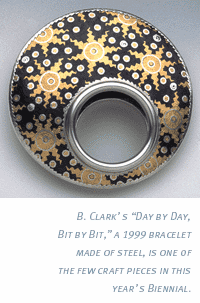 "Painting is reinventing itself all the time," Grachos
says. "(Latané is) someone taking modest textiles,
following the traditions of art, and coming up with a new language
or form."
"Painting is reinventing itself all the time," Grachos
says. "(Latané is) someone taking modest textiles,
following the traditions of art, and coming up with a new language
or form."
Her new language is cheap, shiny, mass-produced fabric, stitched
together--ironically--in the timeless way of women's traditional
crafts. And her form is three-dimensional, sculptural, liberated
from the flat picture plane. "Sparkler" is like painting,
and it's not.
IT'S TEMPTING TO interpret the strong showing of the MOCA group
as a sign of generational change on the Tucson art scene. Their
works usually are seen in alternative spaces, in the rickety HazMat
warehouse hard by the railroad tracks, in the Cherry gallery on
grungy Grant. Now they're spiffed up in a glossy museum, outsider
gone insider.
Sale, Dempsey and Mosset all reprised works from the MOCA opening
in the Biennial. Photographer Joseph Labate made it into
the Biennial and into last month's MOCA show. Museum founders
Latané and photographer James Graham both did well in the
Biennial. Prizewinner Latané got three soft sculptures
accepted; Graham is showing two c-print photographs. Each of them
pictures vivid figures set against deep black.
The MOCA artists are indeed tapped into the national trends,
Stuhr says.
"It's a museum that's started by artists," she says.
"They know young artists, and they went to school with a
number of the artists represented in the show. They've made a
very deliberate and effective effort to identify the artists who
are producing interesting work in the Tucson area. Fortunately
for this museum, a lot of those same artists entered this show."
But Stuhr says it would be reading too much into the overlap
to declare a changing of the Tucson guard. Older, established
artists usually don't enter the Biennial competition; they
see it as a forum for new artists in need of exposure. And along
with Arizona artists who ply straight pins, there are still plenty
who work within conventional genres: painters who paint with paint,
photographers who prize the fine print.
"It's very much a simultaneous trend," Stuhr says.
"We see that in Tucson. There are still people who have been
painting all their lives who are very committed to it. But even
in the new group of younger artists (some) are very dedicated
to painting."
The artists who entered the competition were well aware of the
predilections of curator Grachos. His reputation as a connoisseur
of the cutting edge doubtless kept away at least some traditionalists.
A different curator in two years may very well produce a very
different Biennial. But not necessarily.
"We'll try and do a kind of balance in the jurors we select,"
Stuhr says. "But it is a contemporary show."
Arizona Biennial '99 continues through Sunday,
July 11, at the Tucson Museum of Art, 140 N. Main Ave. Hours are
10 a.m. to 4 p.m. Monday through Saturday, and noon to 4 p.m.
Sunday. Admission is $2 for adults, $1 for seniors or students.
Free for children under 12, for members, and on Tuesdays, free
for everybody. For more information call 624-2333.

|





